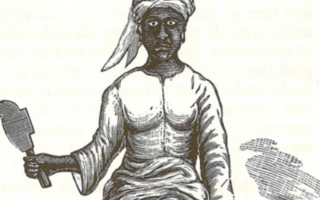Jamaica
The revolt did not end there, as other rebellions broke out all over Jamaica, many of which were rightly or wrongly attributed to Tacky’s cunning and strategy. Other slaves learned of Tacky’s revolt, which inspired unrest and disorder throughout the island. Rebels numbering about 1,200 regrouped in the unsettled mountainous forests in western Jamaica, under the leadership of a rebel slave christened Wager, but going by his African name of Apongo. They attacked eight slave plantations in Westmoreland Parish and two in Hanover Parish, killing a number of whites.
Apongo had been a military leader in West Africa before he was captured and brought to Jamaica as a slave. His enslaver in Jamaica, planter and naval officer Arthur Forrest, was given command of HMS Wager during this time, and subsequently renamed Apongo as Wager; Apongo was then sent by his enslaver to work as a slave on a plantation Forrest owned in Westmoreland Parish. Apongo organised a rebellion, which began on 7 April 1760, and went on until October of the following year. Vincent Brown argues that Apongo’s rebellion in western Jamaica was more significant than Tacky’s uprising in St Mary.
According to Thomas Thistlewood, a planter in western Jamaica who kept a diary, Apongo was a “prince in Guinea”, who paid homage to the King of Dahomey. Thistlewood claimed that Apongo was “surprised and took prisoner when hunting, and sold for a slave.” Vincent Brown argues that Apongo may have been a war chief of Dahomey, or a coastal headman with a troubled relationship with British traders.
On May 25, the western rebellion started when rebels under the command of Apongo rose up in revolt on the Masemure estate in Westmoreland. One of Apongo’s lieutenants, Simon, fired the shot that killed Masemure’s managing attorney, John Smith, and that signalled the start of the western rebellion. The rebels had timed their rebellion to coincide with the departure of a naval escort from the bay of Bluefields, Jamaica, correctly assuming that security would be more lax at that time.
Apongo later admitted that he had planned to attack the bay, but some of his lieutenants argued against an attack on the coast. Vincent Brown surmised that Simon may have been one of those lieutenants who preferred to fight on in the forested mountains
The rebels were well-stocked in their attempts to resist militia counter-attacks. After the assault on the Rebel’s Barricade, militia soldiers found over 70 hogsheads of gunpowder, and mahogany chests full of clothes, ruffled shirts, laced hats, shoes, stockings and cravats, among the basic necessities.
Refugees, both white and black, fled to the Westmoreland capital of Savanna-la-Mar and surrounding ports. Militias counter-attacked with sporadic engagements, and in the process captured and killed a number of rebels. Many of those captured were promptly executed without trial
On May 29, an attempt by the Westmoreland militia to storm the rebels’ barricaded encampment was soundly defeated and repelled. This success resulted in the rebels gaining more recruits by the day, and so demoralised the militia that they started to suffer from significant numbers of desertions.
